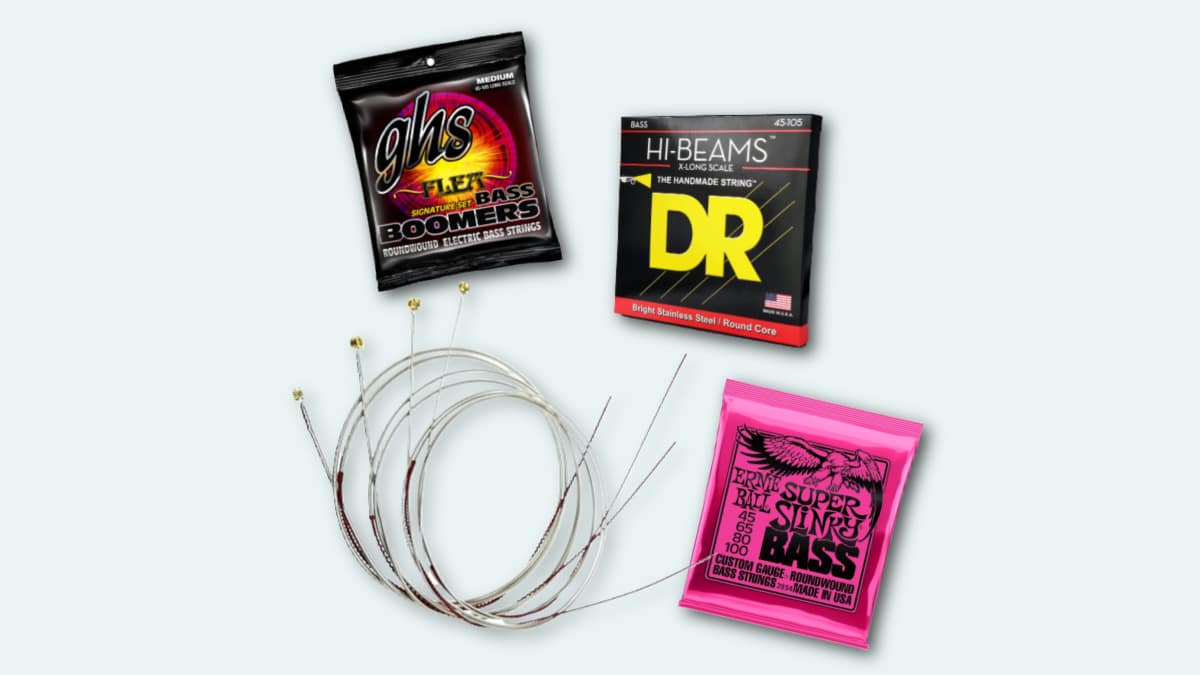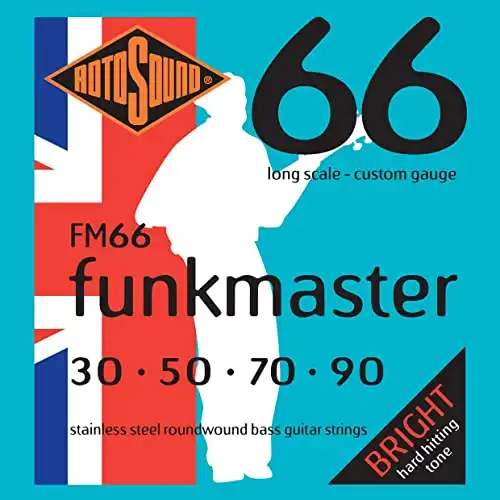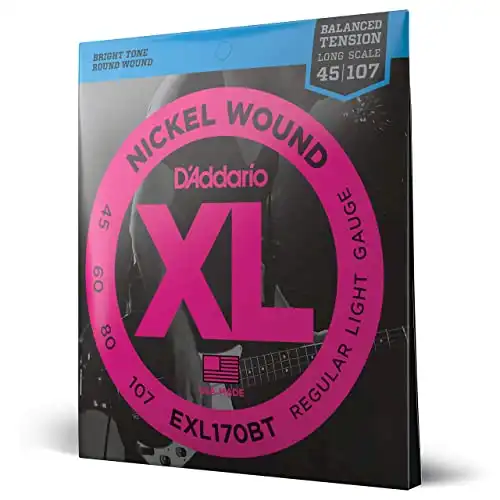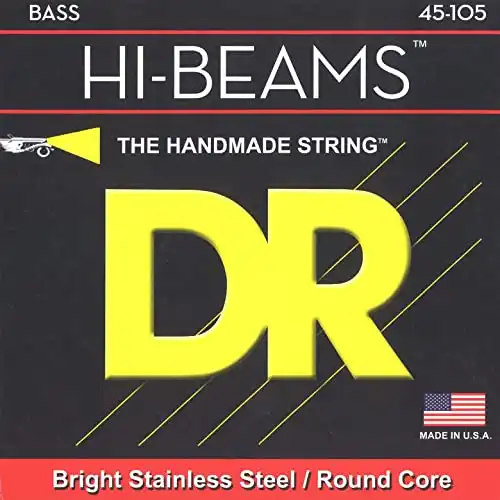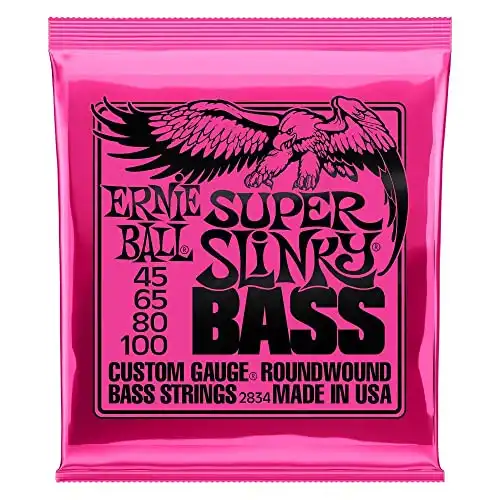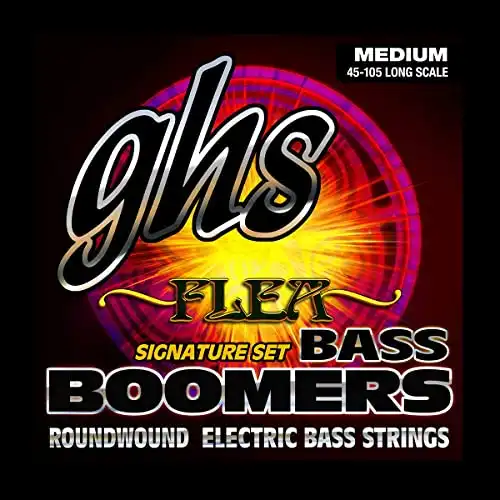Wanna cut to the chase? I reviewed the best bass strings for slapping, and my top pick was the Rotosound FM66 Swing Bass 66 Stainless Steel Funkmaster Strings.
There is nothing on this planet that can match the funk of a slapping bass. The innate beat of the slaps and pops just makes you want to move!
Slap bass has been around for decades. It started back in the 60’s with a bassist called Larry Graham. To see the master in action, check out the video below. The thick beat of his bass is iconic!
To slap effectively you need skill and a good set of strings. We can help with the strings but you’re on your own with the skill.
The best bass strings for slapping are strings that have strength and flexibility. They need to withstand the force of the slap but also be flexible enough to pop.
We’ve put together a buyer’s guide so you can figure out what exactly you’re looking for in slapping strings.
Now let’s check out some of the best bass strings for slapping.
Want to get funky quick?
Top Pick: Rotosound FM66 Swing Bass 66 Stainless Steel Funkmaster Bass Guitar Strings (30 50 70 90)
These strings are super thin and give an amazing bright sound perfect for funk. It’s a beautiful sound.
If you like deeper bass tones then you want to look elsewhere. But, for those of you who want to bring a chirpy bright sound, these are a good option.
These strings are stainless steel and a little rough on the fingers. This does help you grip and will prevent slipping.
However, if you’re not used to thin, rough strings you will need to build up a tolerance.
These strings also come with 60 years of manufacturer experience. Rotosound has been making strings for over 60 years.
Their name is synonymous with quality. They will keep you funky for a long time.
Slapping is a dream on these strings. They are light and responsive.
Sure, they don’t give you as deep a bass line as other strings. But for upbeat funk, pop and jazz, they make beautiful music.
What I Like
- Stainless steel.
- Responsive & springy
- Ultra-light for a bright sound, funky sound.
- Roundwound strings.
- High quality & durable.
- Perfect for slap.
What I Don’t Like
- Slightly rough on the fingers.
- Lacks a deeper bassline.
Editor’s Choice: D’Addario EXL170BT Nickel Wound Bass Guitar Strings
These nickel wound strings produce a nice, mid-range tone. The nickel winding helps to bring out the mid ranges and gives them a sharp metallic sound.
The only issue with these nickel wound strings is that you tend to lose the high and low ranges. This sort of restricts what you can do with your bass sounds.
Roundwound, these strings are also tension balanced. This makes sure that the volume and tone from all 4 strings are consistent.
To be honest, the tension balance makes playing a lot simpler. You don’t need to hit the E and A harder to match the levels of the deeper strings.
You will probably notice the difference in tension. If you’ve never had tension balanced springs before, it can take some getting used to.
Available in a range of gauges, you should be able to find something that suits your style. The light and medium are the best to go for. These will give you the best slapping experience.
What I Like
- Roundwound strings.
- Bright, metallic sound.
- Balanced tension.
- Range of gauges available.
What I Don’t Like
- Not a great deal of range.
Best Value: DR Strings Hi-Beam – Stainless Steel Round Core 45-105
DR Strings are fast becoming a favorite in the music world. Their strings are handmade and of high quality.
These are roundwound strings but they have a round core. Most other strings use a hexagonal core which makes them a bit thicker and stronger.
The round core does, according to users, affect the sound. The strings are more flexible and as a result, have a brighter twang.
If you want a dirty, deeper tone then these may not be for you. The bright sound can be quite harsh because the steel emphasizes the higher-end notes.
These medium gauge strings are fairly easy on the fingers. They won’t rip your knuckle apart when you slap. The fairly light gauge means that popping the lower strings won’t be too difficult on your tendons.
There are lots of happy customers out there who rave about these strings. They work well in many genres but particularly funk and pop. They really shine in these genres because they cut through the sound of the rest of the band.
What I Like
- Stainless steel strings.
- Roundwound.
- Medium gauge is fairly easy on the fingers.
- The round core increases the flexibility of the strings.
What I Don’t Like
- Bright sounds can be somewhat harsh.
- Lacks the deeper crunchy tone used in rock.
Best for Beginners: Ernie Ball Super Slinky Nickel Round Wound Bass Set
Ernie Ball strings are loved by bassists all over the world. They’ve been making these strings for over 50 years and it shows.
The quality of Ernie Ball strings is unbelievable. They tend to stay bright and playable for much longer than competitors.
These particular strings are nickel-plated, roundwound.
Unlike other roundwound strings, these are easy on the fingers thanks to the super slinky coating. You can slide around the strings quickly and efficiently.
The sounds produced by these strings are bright and metallic. They bring out the mid and higher range tones which work well for most genres.
Some customers find that when broken in, the strings lose a little bit of their brightness.
This isn’t uncommon with strings, but the difference seems to be quite pronounced.
The gauge setup gives you slimmer E and A strings.
The lighter strings are more responsive to being popped and have a bit more sustain to them. It gives you a much more layered sound overall.
What I Like
- Roundwound strings.
- Nickel-plated, steel.
- Lighter E and A strings for more responsiveness.
- Durable
What I Don’t Like
- Can lose a little bit of their brightness initially.
Runner Up: GHS Strings BASS BOOMERS M3045F FLEA Signature Set
The major selling point of these strings is the fact that Flea’s name is all over them. According to the manufacturer, these are the strings that Flea uses.
The sick slapping sounds of ‘Can’t Stop’ and other Red Hot Chilli Peppers songs were, they say, created on these strings. Take a look at Flea’s unique style here.
If you’re a fan of the Chilli Peppers or Flea himself, this might be quite a draw.
But let’s take a look at the specifications.
These are roundwound, nickel-plated, stainless steel strings. The nickel plating gives a thick metallic sound associated with nickel strings.
However, the stainless steel makes these strings brighter than normal nickel strings.
In a way, you’re getting the best of both worlds with nickel-plated strings.
The nickel plating also adds some strength to these strings. If you’ve ever seen Flea slap, you’ll understand why strength is key!
The gauge configuration is a custom set up. The G and D strings fall into the regular light gauge, while the A and E strings are medium gauge.
This setup highlights the low and mid-range tones. You get a growly, punchy sound from them.
If you want to get that aggressive, rock sound from your slaps, these could be a good choice.
What I Like
- Roundwound.
- Nickel-plated, stainless steel.
- Light to medium gauge.
- Produces a deep growly sound.
- Durable.
What I Don’t Like
- The strings are fairly rough on your fingers.
- Probably a bit heavy for funk and disco.
Best bass Strings for slapping: Buyer’s Guide
What is slapping?
Common in funk, disco, jazz, and other genres, slapping is a technique that makes the bass more of a percussion instrument.
Slap bass is actually two separate techniques; slapping and popping.
The slap part is created by the knuckle of the thumb slapping against the top two strings. This causes the string to bounce off the frets creating a buzzing noise.
The pop is created by plucking the bottom two strings with the fingers. The strings are pulled away from the body so that they bounce off the frets when released. Again, this causes a buzz but it’s sharper.
These two techniques are used to create a bass beat that sort of sounds like a drum. The deep buzz of the top strings is similar to a bass drum. The pop, meanwhile, mimics a snare. It is a super satisfying sound!
Some of the best bassists out there make groovy, funky music using slapping. Check out this list if you’re in need of some inspiration.
Strings Winding
Bass strings come in three different windings: flatwound, roundwound, and halfwound.
For slapping, you want roundwound strings. These are a steel core wrapped with nickel or stainless steel. On roundwound strings, this outer wrapping is round so the finished string has a bumpy texture.
Roundwound strings are better for slapping because they emphasize the endnotes, high and low.
Slapping works because you get a distinctively different sound out of the slap and pop elements. Flat or halfwound strings just don’t give you the range. They are more mellow and focus on the midrange notes.
String Material
Strings can be made from copper, nickel, steel, or polymers. Each material gives a slightly different sound.
Most bassists use stainless steel strings because they have a better range. The sound of steel strings is brighter, more vibrant. Think of a steel drum and how light and bright that sounds.
Nickel can be used for slapping if you want a thicker sound. Nickel doesn’t have so much of a range of tones as steel. Instead, nickel brings out the mid-range and creates an older, muffled sound.
Try to think about what style you want to play before choosing your strings. As you can see, your style will impact your purchase.
String Gauge
The gauge of the string is the diameter. Essentially it measures how thick the string is. Thicker strings produce deeper tones while thinner strings produce brighter tones.
You want to stick to the light or medium gauge strings for slapping. Thicker strings are too heavy and resistant to respond well to slapping. You’ll ruin your fingers trying to slap with heavy strings.
You want to stick to the light and medium ranges to keep that bright slapping sound. Also, your fingers will thank you!
If you want to know the measurements for the different gauges, you can check out this article.
FAQs
How Do I Maintain My Strings?
So many guitarists and bassists alike neglect the care of their strings. It’s maddening when you think about the fact that you put your fingers all over them every time you play!
I honestly shudder when I think about the school guitars I first learned to play on. The amount of dirt, grease, and sweat that must have collected on those strings. Yuck!
One of the best ways to extend the life of your strings is to just clean your hands before you play. Prevention is the best cure, after all.
Cleaning your hands will remove oils and dirt that would otherwise be transferred to your strings. This not only makes the strings look rank but it affects their sound.
Strings make a sound when they vibrate. This sound is changed depending on how hard the strings vibrate and how thick they are.
Dirt, oil, and grime collect on strings making them heavier and thicker in patches. This affects how the strings vibrate which affects the sound.
The other thing you need to do is wipe your strings after use. Use a microfiber cloth to wipe the full length of your strings. This should remove the sweat and oils that were transferred during playing.
You should wipe your strings after every use. Even if you just picked up the bass for a little play while you wait for the microwave to cook your dinner. Wipe it down!
You should give your bass a deep clean every 3 months. If you don’t feel confident doing it yourself, you can get a shop or service to do it for you.
This video explains how to clean your bass if you need some help with that.
(Here are some more tips on what to use when cleaning your guitar or bass.)
Should You Boil Bass Strings?
There is a common myth that boiling your bass strings will make them good as new. Like most myths, there is some truth to it.
Boiling your bass strings will help loosen the dirt and grime that collects between the coils of your string.
You can boil your strings for up to ten minutes. Any longer and you’ll start to damage the coating.
Once you remove them from the water, use a clean towel to dry them off. Try to get as much of the water off as possible.
You then need to place the strings in a parcel of foil. Perforate the foil with a fork and then put the parcel in the oven on the lowest setting.
Let the strings oven dry for fifteen minutes before removing them. You need to let them cool before you restring them.
You should notice that your strings sound brighter than before. They won’t sound like new but it may be an improvement.
The problem with boiling your strings is that a lot can go wrong. If there are any imperfections or dinks in your string, the heat can make them critical.
When you restring your guitar you run the risk of the strings snapping at those critical points.
You shouldn’t boil your strings over and over. At some point, you need to bite the bullet and just replace them. Boiling your strings more than once will weaken them to the point of snapping.
How To Replace Your Bass Strings?
First things first you need to remove the old strings.
To do this, detune them a bit so they are no longer taught. Then you can cut them close to the bridge. Use a set of wire cutters to do this or you run the risk of injury.
Once you’ve cut the strings you can pull them out of the bridge. Make sure to get rid of all the old string pieces. They can be quite sharp when cut.
To fit the new strings you need to feed the strings through the holes in the bridge. The ball end of the string should fit snugly in the hole. This will stop the strings from falling out.
Now comes the tough part. You need to feed the string through the hole in the middle of the tuning key.
It needs to be far enough in that when you turn the key it doesn’t slip out. However, you don’t want it to poke out of the tuner.
When you turn the key you want the string to remain straight. So pay attention to the way the string moves when you turn it.
Depending on the set up of your headstock, not all keys are going to turn the same way.
You might find that you have too much string to wind around the nut. If this is the case just snip off the end. Do this last, once you know how much string is left over.
For a more comprehensive guide and some handy tutorial videos, take a look at this how-to article.
How can I get More Bass effects?
Bass amps don’t usually come with a lot of effects. So if you’re looking to modulate your sound, you might try a bass distortion pedal or a bass fuzz pedal.
Or any other effects pedals for bass. 🙂
Final Thoughts
I hope you found my guide on the best bass strings for slapping to be helpful. 🙂
If you want to learn more about bass guitars, check out my post about how long it takes to learn bass guitar.
And if you have any feedback, feel free to contact me here.






